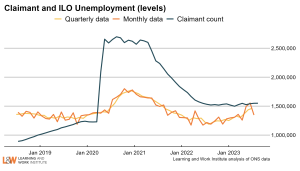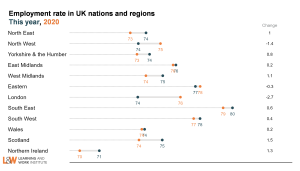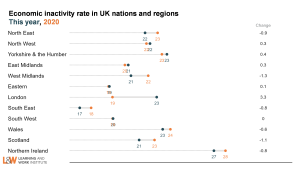September 2023
1. The scale of real wage reductions is falling as inflation declines
The latest data show average regular earnings grew by 7.8% in the year to July 2023. For public sector workers average regular earnings grew by 6.6%, while average regular earnings grew by 8.1% for private sector workers. Declining inflation means real regular earnings went up by only 0.6% (3-month average change) in the year to July 2023, with the single month data for July showing an increase of 1.2% in the year to July 2023. Inflation decreased in July – CPIH decreased from 7.3% in June to 6.4 in July. Core CPIH (excluding energy, food, alcohol and tobacco) in July remained the same as June, at 6.9%. Also, inflation in areas like food and non-alcoholic beverages is still very high. The UK remains an inflation outlier, as inflation continues to fall across all other advanced economies. The United States is currently experiencing an inflation rate of 3.2% while the Eurozone average is currently 5.3%.

2. There are fewer potential workers for employers to recruit, with 592,000 fewer over 50s in the labour market since the pandemic started
Recruitment is more challenging for employers because of rises in economic inactivity – people leaving the labour market. This has been primarily driven by those aged 50 and over and people with long-term health problems and disabilities. The number of people aged 50-64 who are economically inactive has increased by 8.6% since the pandemic started.
Economic inactivity rose slightly in the most recent quarter and the number of those aged 16-64 who are economically inactive remains 411,000 higher than pre-pandemic. Despite this, only one in ten out-of-work people who are older or have a disability get employment support each year. The Government needs to extend employment support to more people outside the labour market and employers need to think about recruitment and job design to attract and retain staff.

3. Current levels of economic activity have many causes
Post-pandemic increases in economic inactivity have been heavily influenced by the numbers of individuals inactive due to long-term health problems, which have increased by 23.3% since the December 2019–February 2020 quarter. Other important contributors to the increased level of economic inactivity include students, whose numbers have risen by 5.9% since the start of the pandemic. By contrast, the number of individuals inactive due to family / home responsibilities has decreased by 15.5%, and the number of individuals who are retired has decreased by 3.5% over the same period. The number of economically inactive individuals who do not want to work has increased by 9.1% since the start of the pandemic, while the number of economically inactive individuals who do want to work has decreased by 10%. However the number of discouraged workers (those who are not looking for work because they believe no jobs are available) has decreased by 41.3% since the start of the pandemic.

4. The unemployment rate is continuing to rise
The official quarterly unemployment rate has been rising over the past year, from a low point of 3.5% in June – August 2022 to 4.3% in the latest quarter (May – July 2023). 1,464,000 people were unemployed in the most recent quarter while the number of unemployed people who are claiming unemployment-related benefits is 87,000 higher than the number of unemployed on the official measure.

5. The employment picture varies across the country
Employment rates this quarter are higher than the equivalent quarter in 2020 in the North East, Yorkshire and the Humber, East and West Midlands, South East, South West, Wales, Scotland, and Northern Ireland, and lower in the North West, Eastern and London regions. The largest increase was seen in Scotland while the largest decrease was seen in London.
Economic inactivity this quarter is higher than the equivalent pre-pandemic quarter everywhere except the North East, the West Midlands, the South East, Wales, Scotland and Northern Ireland. The West Midlands saw the largest decline in economic inactivity, while the largest increase was seen in London. This varying picture, which is even greater at sub-regional level, shows the importance of tackling inequalities so everyone has a fair chance in life wherever they live.

